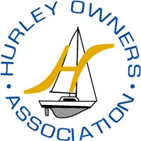


SEACOCKS AND SKIN FITTINGS ON YOUR HURLEY
Seacocks are present to shut off the flow of water from or to items of plumbing aboard the vessel. There are three types of seacocks:
-
the gate valve type, which is like the domestic plumbing type with a red wheel, which is turned clockwise to close;
-
the ball valve type, which is preferred by many and has a lever to operate a chrome-plated bronze ball;
-
and the traditional 'Blakes' type, which is complex in its construction and is comprised of a tapered peg, which is rotated by a lever inside a bronze housing.
Whatever type is used on your vessel, they should always be turned off when you leave the vessel, or, in the instance of the sink and sea toilet plumbing, they should be shut off whilst at sea. However, the cockpit drain seacocks should be left on when leaving the boat to drain away rainwater.
The seacocks should be made of bronze and not brass, as is the case with domestic plumbing items that you get from a DIY shop. Bronze is more resistant to electrolytic and galvanic corrosion, which is a major problem on boats. When you buy new seacocks, you should ask the seller if they are bronze. There are several different types of bronze, including Monel, but all include a mixture of copper, zinc and tin. Brass is softer and the zinc can leach out away from the copper too easily.
Bronze
is best as you do not need to wire seacock to an anode. This is because
bronze does not contain very much zinc. Brass is often known as commercial
bronze as it is an alloy of copper, zinc and tin. DZR is the most common
material used for seacocks. DZR stands for Dezincification Resistant
Brass but is actually a type of bronze. So go for DZR or pure bronze.
Brass is too soft and contains too much zinc which leaches out of the
metal. Pure bronze is 88% copper 12% tin. Pure brass is 90% copper 10%
zinc. Both are alloys so mixtures of the metal are used. Other derivatives
of copper, tin, zinc and lead are gun metal and yellow metal.
You should check your seacocks every time that you visit your boat. This should be done at least once a month, the seacock handle or lever should be turned from fully open to close a few times so that it does not seize up. You should check for leaks. The gate valve and ball valve types should not leak at all, but the Blakes type often drip a little, as they rely on a tapered peg with holes through it being pushed into a flange.
You should scrape the seacock every year to see if it has corroded. A penknife or screwdriver should be used to scrape at the oxidised body of the valve. If it is bright yellow when scraped, all is well, but if it is pinkish, it means that the zinc in the metal has started to leak away by electrolytic corrosion. The seacock should be changed without delay if found to be corroded, as the metal will be brittle and might break off if the handle is turned. Most sunken boats that I come across have come to grief because of a failed or leaking seacock. This is a major weak point on any vessel.
Seacocks are mostly used below the waterline of the hull. They are screwed to a flange called a skin fitting, which is fitted to the hull to create a hole through which water can escape or enter the vessel.
Skin fittings are usually made of gunmetal, which is a mixture of copper, zinc, tin and chromium and is similar to bronze. Skin fittings used below the waterline should not be made of nylon or other plastics, as they can become brittle and crack in time. Nylon is, however, used above the waterline for items such as bilge pump outlets and gas bottle locker drains. Here are some examples of seacocks and skin fittings:
-
Cockpit drains - usually two and found under the cockpit;
-
Engine raw water coolant intake, sometimes with a strainer;
-
Sea toilet effluent outlet;
-
Sea toilet flushing water inlet;
-
Galley sink and vanity basin drains.
Flexible hoses of reinforced PVC should be attached to hose flanges or the seacocks with two stainless steel 'jubilee'-type hose clips.
Some
seacocks are made of plastic. They are fitted to some new European and
American yachts and work well.
Forespar corrosion and electrolysis free lightweight
plumbing units are an example
Flexible hoses fitted to the seacocks should be of re-enforced PVC and not plain clear PVC. Plain clear hoses crack with age. Flexible hoses should be fitted to the seacock flanges by two hose clips at each hose end.
Nick
Vass.
Technical Advisor HOA